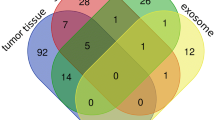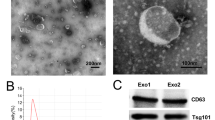Summary
This study aimed to investigate infiltration related microRNAs (miRNAs) in bladder urothelial carcinoma (BUC). Twenty patients with BUC were enrolled and divided into 2 groups according to infiltration or not: infiltrating BUC group (n=12) and non-infiltrating BUC group (n=8). Gene chip was used to detect infiltration related miRNAs in the BUC samples. In other recruited 17 patients with BUC who were divided into infiltrating BUC samples (n=14) and non-infiltrating BUC samples (n=3), and in 4 BUC cell lines (EJ, 5637, T24 and BIU-87), the expression of miRNAs was assayed by using reverse transcription-polymerase chain reaction (RT-PCR). In infiltrating BUC group, as compared with non-infiltrating BUC group, there were 7 differentially expressed miRNAs: hsa-miR-29c, hsa-miR-200a, hsa-miR-378, hsa-miR-429, hsa-miR-200c and hsa-miR-141 were up-regulated, while hsa-miR-451 was down-regulated. In the BUC samples, the results of RT-PCR were consistent with those by the miRNA array. In the cancer cell lines, RT-PCR in T24 only revealed the similar expression pattern of miRNAs to that by the miRNA array. It is suggested that infiltration of BUC is related with different expression of miRNAs, which may provide a novel platform for further study on function and action mechanism of miRNAs.
Similar content being viewed by others
References
Fleshner NE, Herr HW, Stewart AK, et al. The national cancer data base report on bladder carcinoma. The American college of surgeons commission on cancer and the American cancer society. Cancer, 1996,78(7):1505–1513
Jing KZ, Gao JP, Cheng W. Gene therapy for bladder cancer: past and future. J Med Postgrad, 2007,20(8):861–864
Xu F, Gao JP, Cheng W. MicroRNA and cancer. Dongnan Guofang Yiyao (Chinese), 2008,10(6):436–438
Lee RC, Feinbaum RL, Ambros V, et al. The C. elegans heterochronic gene lin-4 encodes small RNAs with antisense complementarity to lin-14. Cell, 1993, 75(5):843–854
Zhang BH, Pan XP, Cobb GP, et al. Plant microRNA: a small regulatory molecule with big impact. Dev Biol, 2006,289(1):3–16
Cheng AM, Byrom MW, Shelton J, et al. Antisense inhibition of human miRNAs and indications for an involvement of miRNA in cell growth and apoptosis. Nucleic Acids Res, 2005,33(4):1290–1297
Eble JE, Sauter G, Epstein JI, et al. Pathology and genetics tumours of the urinary system and male genital organs. Lyon: IARC Press, 2004:96–117
Johnson SM, Grosshans H, Shingara J, et al. RAS is regulated by the let-7 microRNA family. Cell, 2005,120(5):635–647
Cimmino A, Calin GA, Fabbri M, et al. miR-15 and miR-16 induce apoptosis by targeting BCL2. Proc Natl Acad Sci USA, 2005,102:13944–13949
Iorio MV, Ferracin M, Liu CG, et a1. MicroRNA gene expression deregulation in human breast cancer. Cancer Res, 2005,65(16):7065–7070
Michael MZ, O’Connor SM, van Holst Pellekaan NG, et a1. Reduced accumulation of specific microRNAs in colorectal neoplasia. Mol Cancer Res, 2003,1(12):882–891
He L, He X, Lowe SW, et al. MicroRNAs join the p53 network-another piece in the tumor-suppression puzzle. Nat Rev Cancer, 2007,7(11):819–822
Lu J, Getz G, Miska EA, et al. MicroRNA expression profiles classify human cancers. Nature, 2005,435(7043): 834–838
Volinia S, Calin GA, Liu CG, et al. A microRNA expression signature of human solid tumors defines cancer gene targets. Proc Natl Acad Sci USA, 2006,103(7):2257–2261
Cardiff RD. Epithelial to mesenchymal transition tumors: fallacious or snail’s pace? Clin Cancer Res, 2005,11(24 Pt 1):8534–8553
Thompson EW, Newgreen DF, Tarin D. Carcinoma invasion and metastasis: a role for epithelial-mesenchymal transition? Cancer Res, 2005,65(14):5991–5995
Gregory PA, Bracken CP, Bert AG, et al. MicroRNAs as regulators of epithelial-mesenchymal transition. Cell Cycle, 2008,7(20):3112–3118
Gregory PA, Bert AG, Paterson EL, et al. The miR-200 family and miR-205 regulate epithelial to mesenchymal transition by targeting ZEB1 and SIP1. Nature Cell Biol, 2008,10(5):593–601
Park SM, Gaur AB, Lengyel E, et al. The miR-200 family determines the epithelial phenotype of cancer cells by targeting the E-cadherin repressors ZEB1 and ZEB2. Genes Dev, 2008,22(7):894–907
Korpal M, Lee ES, Hu G, et al. The miR-200 family inhibits epithelial-mesenchymal transition and cancer cell migration by direct targeting of E-cadherin transcriptional repressors ZEB1 and ZEB2. J Biol Chem, 2008,283(22): 14910–14914
Burk U, Schubert J, Wellner U, et al. A reciprocal repression between ZEB1 and members of the miR-200 family promotes EMT and invasion in cancer cells. EMBO Rep, 2008,9(6):521–522
Kong W, Yang H, He L, et al. MicroRNA-155 is regulated by the transforming growth factor beta/Smad pathway and contributes to epithelial cell plasticity by targeting RhoA. Mol Cell Biol, 2008,28(22):6773–6784
Negrini M, Calin GA. Breast cancer metastasis: a microRNA story. Breast Cancer Res, 2008,10(2):203
Huang Q, Gumireddy K, Schrier M, et al. The microRNAs miR-373 and miR-520c promote tumor invasion and metastasis. Nat Cell Biol, 2008,10(2):202–210
Zhu S, Wu H, Wu F, et al. MicroRNA-21 targets tumor suppressor genes in invasion and metastasis. Cell Res, 2008,18(3):350–359
Asangani IA, Rasheed SA, Nikolova DA, et al. MicroRNA-21 (miR-21) post-transcriptionally downregulates tumor suppressor Pdcd4 and stimulates invasion, intravasation and metastasis in colorectal cancer. Oncogene, 2008,27(15):2128–2136
Li T, Li D, Sha J, et al. MicroRNA-21 directly targets MARCKS and promotes apoptosis resistance and invasion in prostate cancer cells. Biochem Biophys Res Commun, 2009,383(3):280–285
Yang K, Handorean AM, Iczkowski KA. MicroRNAs 373 and 520c are downregulated in prostate cancer, suppress CD44 translation and enhance invasion of prostate cancer cells in vitro. Int J Clin Exp Pathol, 2009,2(4):361–369
Gandellini P, Folini M, Longoni N, et al. miR-205 exerts tumor-suppressive functions in human prostate through downregulation of protein kinase Cepsilon. Cancer Res, 2009,69(6):2287–2295
Author information
Authors and Affiliations
Corresponding author
Additional information
The two authors contributed equally to the work
Rights and permissions
About this article
Cite this article
Xie, P., Xu, F., Cheng, W. et al. Infiltration related miRNAs in bladder urothelial carcinoma. J. Huazhong Univ. Sci. Technol. [Med. Sci.] 32, 576–580 (2012). https://doi.org/10.1007/s11596-012-0099-2
Received:
Published:
Issue Date:
DOI: https://doi.org/10.1007/s11596-012-0099-2




